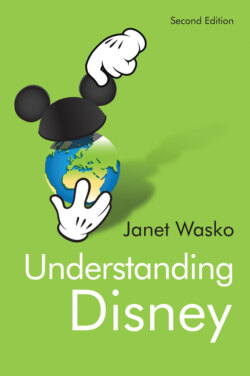Читать книгу Understanding Disney - Janet Wasko - Страница 24
Genius on ice?
ОглавлениеWalt Disney was aged 65 on December 15, 1966 when he died after an acute circulatory collapse following surgery for lung cancer. His death prompted extensive adulation worldwide as the popular press sang his praises once again. Jackson cites Eric Sevareid’s eulogy on CBS Evening News:
He was an original; not just an American original, but an original, period. He was a happy accident; one of the happiest this century has experienced; and judging by the way it’s been behaving in spite of all Disney tried to tell it about laughter, love, children, puppies, and sunrises, the century hardly deserved him. He probably did more to heal or at least to soothe troubled human spirits than all the psychiatrists in the world. There can’t be many adults in the allegedly civilized parts of the globe who did not inhabit Disney’s mind and imagination at least for a few hours and feel better for the visitation.58
The acclaim that Disney received during his life was far-reaching. As reported in one of many biographies of Walt on the company’s website:
A pioneer and innovator and the possessor of one of the most fertile imaginations the world has ever known, Walt Disney, along with members of his staff, received more than 950 honors and citations from every nation in the world, including 48 Academy Awards and seven Emmys in his lifetime. Walt Disney’s personal awards included honorary degrees from Harvard, Yale, the University of Southern California, and UCLA; the Presidential Medal of Freedom; France’s Legion of Honor and Officer d’Académie decorations; Thailand’s Order of the Crown; Brazil’s Order of the Southern Cross; Mexico’s Order of the Aztec Eagle; and the Showman of the World Award from the National Association of Theatre Owners.59
However, certain aspects of Disney’s life have been consistently underemphasized or simply left out of most accounts. As Bryman suggests, there was some “ambiguity about Walt’s status as a businessman”; for instance, in most accounts, the company’s extensive merchandising activities are neglected.60 Yet there is considerable evidence that Walt Disney was interested and involved in the business side of the company, not merely in artistic or other kinds of success. Disney once advised: “Don’t create potboilers. Create masterpieces. There’s such a big market for masterpieces.”61 In 1953, over the objections of his brother Roy, he set up a company to control the rights to his name. Retlaw – Walter spelled backwards – received 5 percent of the income received by the company from merchandising and, by the 1960s, was drawing about $500,000 each year.62 Disney died a rich man.
Jackson writes: “Walt Disney, the man, may be gone. However, the myth he created remains very much alive.” As noted at the beginning of this chapter, many of the myths have been perpetuated through biographies that accept the Disney legacy without question. Given the ongoing predilection for “great-man history,” as well as the growing fascination with celebrity biographies, the pseudo-religious profiles of Walt Disney will probably continue.
As Bryman observes, “‘Walt Disney’ is also in a sense a social construction – a product of his own and others’ efforts at creating a public face and a personal biography that would serve his business’s aims.”63 In other words, the myths associated with Walt Disney benefit the company and will continue to be promoted as such. Previously, the Disney company’s website included the “Walt Disney Family Museum,” with “Walt’s Story,” “Walt’s Thoughts,” a “Family Album,” film clips, a “Walt Disney Dictionary,” more detailed biographical material by historians Katherine and Richard Greene, and other special features (such as a gift shop).
The promotion of the Walt Disney legacy has shifted from this digital version to an actual “Walt Disney Family Museum,” which opened in 2009 in the Presidio area of San Francisco. The museum was created by the Walt Disney Family Foundation, a non-profit organization that was incorporated as a private operating foundation in 1997, “to assemble material, study, teach and preserve, and publish and display material appropriate to communicate the vision and legacy of Walt Disney within a historical context.”64
There has been a fairly widespread rumor that Walt’s body is on ice somewhere, waiting to be revived cryogenically when medical science becomes capable of healing his fatal affliction.65 However, the company and the Disney family report that his ashes were interred at Forest Lawn Memorial Park in Glendale. With the 1,700 robots at the theme parks, one might wonder why there are not Audio-Animatronic versions of Walt Disney, strategically placed at each theme park to greet guests and tell them his version of Disney history.
